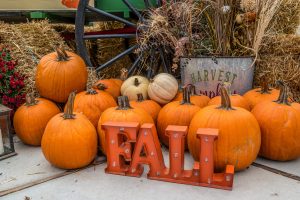Pumpkins can extend beyond Halloween
October 27, 2022
Their post-harvest life depends on where you get them, how long they’ve been sitting and how they are displayed. Using them outside in the weather or staging them with other organic matter like hay can speed up decomposition.
Pumpkins are a fall staple and a great way to add a bit of festive decor to your home. I’ve had a pumpkin display out at my home since mid-September. I’ll keep this fall arrangement up until after Thanksgiving and then replace it with Christmas lights and decor.
Although pumpkins have a long post-harvest life, factors like weather and the condition of the pumpkin can lead to early decomposition and rot.
Here are some tips to help extend the life of your pumpkins before they turn into a gushy mess:
- One of the most important things you can do is find pumpkins with no surface damage. Don’t buy pumpkins with bruises and signs of rotting. Pumpkins without damage generally last longer than those with defects.
- Where you place your pumpkin display can also play a role in how long they will last. When setting up your fall decor, avoid wet areas. Find a spot that is well drained to avoid decomposition. Reid Nevins, MSU Extension agent and longtime pumpkin grower, recommends wiping down pumpkins with a 1-part bleach, 10-parts water solution to kill bacteria before setting them outside.
Extending A Pumpkin’s Life
Pumpkins last a fairly long time off the vine, she said. Their post-harvest life depends on where you get them, how long they’ve been sitting and how they are displayed. Using them outside in the weather or staging them with other organic matter like hay can speed up decomposition.
Pumpkins used to hold flower arrangements, but suggests carving out just enough of the pumpkin to hold a vase. Arrange and water the flowers inside the vase to reduce the moisture levels inside the pumpkin and try to keep some space between the pumpkin and the arrangement.
Because pumpkins can have an extended post-harvest life, uncarved pumpkins used for Halloween décor could be used for fall cooking going into the holidays, she said.
“If you buy a whole pumpkin and let it sit for weeks and it doesn’t show any signs of decay, you are probably fine to use the pumpkin meat,” she said. “Check for mushy or rotting areas, any sign of decomposition inside the pumpkin or a bad smell. Just check for anything that suggests decay.”
Composting pumpkin remains
When your pumpkin does ultimately decay, adding pumpkins to compost piles is a good way to use the leftover organic matter, said Joe Masabni, AgriLife Extension horticulturist.
It’s best to either blend them up or let them dry and break the rinds up into as small of pieces as possible, he said.
“The smaller the pieces, the better, so it will break down and compost quicker,” he said. “Composting seeds and all can be fine, but you need to break them up as well, otherwise some may germinate in your compost pile.”
Saving seeds to plant
When you are done with your pumpkin this season, seeds can be saved to plant next year by laying them out flat to air dry on paper towels, Masabni said. They should be dried enough within 24 hours and then can be placed in a plastic bag and stored in the refrigerator or a cool, dry place. Mark the bag with the pumpkin variety and date.
“If they’re stored correctly, they can last at least five years,” he said. “Don’t heat dry them in an oven or in the sun because it’s like roasting them and could cause damage.”
(SOURCES: Mississippi and Texas university extension services)







